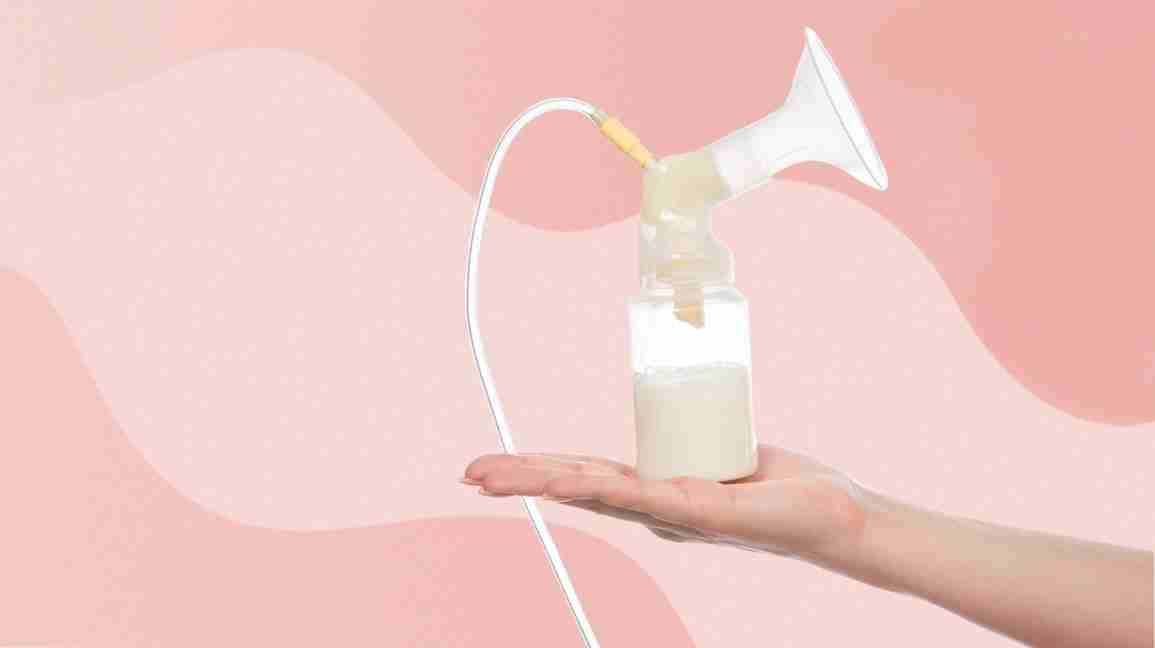We include products we think are useful for our readers. If you buy through links on this page, we may earn a small commission. Here’s our process.
- Best wireless hands-free pump: Elvie Pump
- Most versatile hands-free pump: Freemie Liberty Wearable Breast Pump System
- Most discreet hands-free pump: Willow Generation 3
- Best budget-friendly hands-free pump: iAPOY Wearable Portable Breast Pump
- Most comfortable hands-free pump: Medela Freestyle Flex Breast Pump
- Best manual wireless pump: Haakaa Silicone Breast Pump
Whether you’re planning ahead for your back-to-work milk stash, or already in the thick of pumping and thinking, who has time for this?!, juggling breastfeeding, pumping, and milk storage can be overwhelming.
We’re here to help with some of the best time-savers on the market: hands-free breast pumps.
If you choose to breastfeed, you’ll spend a LOT of time (as in, 6 to 8 hours per day during the first few months) nursing your baby. If you’re pumping to boost your milk supply, or build up a stash for time away from baby, you’ll spend even more time.
This can sound like a daunting task (and it is), but it’s one that’s rich in benefits for you and your baby! One way to get a little time back and still meet your breastfeeding goals is by using a hands-free breast pump.
Traditional electric breast pumps must be plugged into the wall and held against the breast during your pumping session (which may take 10 to 30 minutes each). Hands-free breast pumps give you the freedom to multitask and reclaim some time for yourself while pumping.
Sometimes the term “hands-free pump” can be misleading, as many manufacturers use the phrase to refer to pumps that are wireless (meaning they don’t have to be plugged in) and don’t use tubing. A pump can be wireless, but not necessarily hands-free.
A true hands-free option should be wearable under your clothing (which can come in really handy if you have to pump somewhere public, such as a plane, in your office, or on a Zoom call). They are usually much more portable and quicker to set up than typical breast pumps.
Or, you can purchase a pumping bra (here’s one we highly recommend!) to convert any wireless pump into a hands-free pump, leaving you free to check email or eat a snack while you pump. These often work with non-wireless options, too, you’ll just have to stay put by an outlet.
- Double up. If you’re pumping with much frequency, you’ll likely want a double breast pump. This allows you to pump both breasts at the same time, which will obviously speed up your pumping sessions. However, you can save quite a bit of money if you prefer a single breast pump.
- Discretion. If you want to be able to use your pump more discreetly at work or in public settings, a quiet motor may be high on your priority list.
- Suction settings. Additionally, plenty of suction power (which can be variable, particularly among battery-powered pumps) and adjustable settings will allow you to get good milk output and adjust the suction to your comfort level.
- Ease of use. The whole point of hands-free pumping is to save time, so you want a pump that requires minimal setup.
We talked to real moms, read reviews, and considered factors such as price, features, and availability to bring you our list of top hands-free breast pumps.
Everyone’s breastfeeding needs are a little different, so we tried to find something for every lifestyle, budget, and preference. We hope this makes one decision in your life as a new parent a little easier!
Price guide
- $ = under $100
- $$ = $100–$250
- $$$ = $250–$400
- $$$$ = $400–$500
Best wireless hands-free pump
Elvie Pump
Price: $$$$
There are only a few truly hands-free, wearable, portable, wireless breast pumps on the market, and one is the Elvie Wearable Breast Pump. Available in a single or double set, the Elvie is shaped like a large plastic bra cup, and fits right inside your regular nursing bra.
This pump is truly wireless — you just recharge it every few uses via a micro USB cord. That means you can literally walk around your house, sit at your desk, or run a Zoom meeting with these pumps working at the same time. The collection cups hold 5 ounces each, and there are three sizes of suction cups available to fit most breasts.
On the con side, some users noted that if you move around too much (or try to lie down for a nap) the Elvie will leak. Others noted that the free app (which helps keep track of your pumping times and output) is not very accurate. Some moms also felt the suction was not as strong as their traditional electric pumps, but this seems to vary based on how well the pump flange fits you.
Moms do rave about Elvie’s customer service, saying that troubleshooting and getting replacement parts is a breeze. It also has the quietest motor available, which gives you the most multitasking options possible while you pump.
Most versatile hands-free pump
Freemie Liberty Wearable Breast Pump System
Price: $$–$$$
We’ve ranked the Freemie system as the most versatile hands-free pump because the collection cups and tubes can be used with the Freemie battery operated pump (no cords!) or with your regular, insurance-covered breast pump (if you don’t mind being plugged into the wall or want stronger suction).
The Freemie Milk Collection Cups come with the Liberty Pump, or can be purchased separately if you just want to convert your existing pump to a hands-free option. Most moms love the discreet fit, large collection cup capacity, and ease of use of the Freemies.
It’s worth noting that not all pumps are compatible with the Freemie Cups, so be sure to check their list of compatible pumps to see if yours will work.
Buy the Freemie Liberty Wearable Breast Pump System online.
Most discreet hands-free pump
Willow Generation 3
Price: $$$$
A direct competitor of the Elvie Pump, the Willow Generation 3 is another completely wireless, completely hands-free pump. The large plastic cups fit into your nursing bra, and once latched, pump while you perform almost any other activity.
Favorite features include the app (which allows control of the pump and tracking of milk output), the mobile lifestyle it offers, and the comprehensive package of supplies that you get for the price.
The Willow gets better reviews for mobility (e.g., not leaking while you’re moving around), but is a bit louder than the Elvie. And, the Willow’s collection cups or bags also only hold 4 ounces, which might mean you need to switch them out part way through your pumping session.
Worth noting: Some moms say that the suction is actually too strong and may be painful. And parents also reported frequent error messages from the pump saying it needed to be adjusted, which of course disrupts your pumping session.
Buy the Willow Generation 3 online.
Best budget-friendly hands-free pump
iAPOY Wearable Portable Breast Pump
Price: $$
This newcomer to the hands-free pump market is also by far the least expensive option for a double, cordless, wearable breast pump. It’s absolutely tiny, and gets good reviews overall for portability and ease of use.
While most moms didn’t feel it was quiet enough to use comfortably in public, many said they love it for use around the house. Who knew you could wash dishes and pump liquid gold for your baby at the same time?
One con that several moms noted is that the flange is not adjustable for different nipple sizes, so some individuals may not get a good fit from this pump. However, if it fits you, it’s a great budget-friendly option.
Buy the iAPOY Wearable Portable Breast Pump online.
Most comfortable hands-free pump
Medela Freestyle Flex
Price: $$$
The combination of Medela’s silicone-lined flanges and the Medela Hands-Free Pumping Bra (sold separately) make this the most comfortable option for hands-free pumping, according to almost every mom we talked to.
The Medela Freestyle Flex has flanges and a bottle collection system that is similar to traditional pumps (versus the in-bra shape of the Elvie or Willow), so you can’t necessarily pump under your clothes. However, if comfort is a priority for you, this is a great choice.
The pumping bra is soft, comfy, and comes in several sizes. You fit the flanges through the bra, then simply click a button on the tiny, battery operated pump (it almost looks like a small TV remote). The whole system easily fits in a purse or bag, and features simple USB charging. Medela replacement supplies are also very widely available and reasonably priced.
The main con for this pump is that the suction decreases dramatically as the battery wears down, so you’ll need to keep it fully charged to get the best milk output possible.
Buy the Medela Freestyle Flex online.
Best manual wireless pump
Haakaa Manual Breast Pump
Price: $
While it’s definitely not hands-free, we figured this unique little pump is worth mentioning if you’re looking for a wireless option. It’s a simple silicone suction cup — you literally squeeze it, attach it to your breast, and let go. Milk is extracted as the suction releases.
While it’s unlikely to collect enough milk to be your only pump, you can use it to catch milk from one breast that would otherwise be lost while you’re nursing on the other side. It’s also great for relieving breast fullness between feedings or keeping in your bag in case you ever happen to be out without your baby or your electric pump.
It’s very inexpensive and easy to clean, but due to its shape, the Haakaa does tip over easily. It may be worth purchasing the separate storage lid.
The pros of hands-free pumping are pretty obvious: Who couldn’t use extra time in their day?!
New parents are a busy crowd. Whether you’re exclusively pumping or you’re pumping to feed your baby when you go back to work, you’re already spending a lot of time feeding and caring for your little one (two words: diaper changes).
If you pump three times per day for 20 minutes each, a hands-free pump can give you back an hour each day to accomplish other tasks (while you’re simultaneously accomplishing the amazing task of feeding your baby!). That amount of time can make a huge difference in your stress level, as well as how long you feel able to continue breastfeeding.
The major con to a true hands-free pump is the cost. These pumps are not typically covered by insurance (since 2012, as a result of the
You can usually use funds from an FSA or HSA to pay for a hands-free pump, but the pump itself may be fairly costly. Wearable, hands-free pumps are quite a bit more expensive than regular electric breast pumps.
Another con is that some moms find it much harder to get the proper latch with a hands-free pump (versus being able to manually adjust the feel and fit of the pump flanges), which may result in leaking of milk or decreased pumping output.
You’re already a supermom for breastfeeding your baby — and pumping on top of that. A hands-free breast pump may make your life a little easier, and help you focus on the things that are important to you — like your precious new baby.

